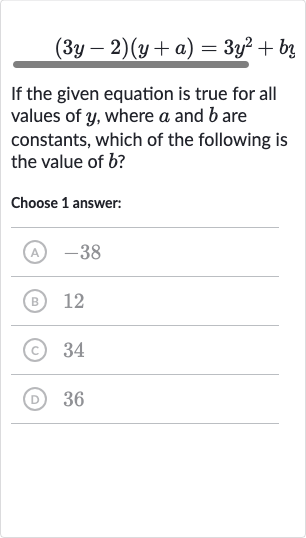Full solution
Q. If the given equation is true for all values of , where and are constants, which of the following is the value of ?Choose answer:(A) (B) (C) (D)
- Expand and Compare: We need to expand the left side of the equation to compare it with the right side .
- Simplify Expression: Now we simplify the expression by multiplying the terms.
- Comparison with Right Side: We compare the simplified expression with the right side of the given equation.
- Coefficient Comparison for : Since the equation is true for all values of , the coefficients of the corresponding terms on both sides must be equal. This means that the coefficient of on the left side must be equal to the coefficient of on the right side, which is (since there is no term on the right side).
- Solve for : We solve for .
- Constant Term Comparison: Now we look for the constant term on the left side, which is , and compare it with the constant term on the right side, which is .
- Substitute Value of a: We substitute the value of into the equation.
- Determine Coefficient for : Since there is no term on the left side of the original equation, the coefficient of on the right side must be . Therefore, must be .
More problems from Transformations of absolute value functions: translations and reflections
QuestionGet tutor help
QuestionGet tutor help
QuestionGet tutor help
QuestionGet tutor help
QuestionGet tutor help
QuestionGet tutor help
QuestionGet tutor help
QuestionGet tutor help
QuestionGet tutor help

